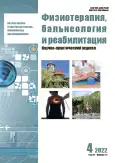The effectiveness of ultrasound therapy and phonophoresis in the treatment of ankylosing spondylitis
- Authors: Al-Zamil M.K.1,2, Stepanovich M.А.1,2, Kulikova N.G.1,3, Vasilieva E.S.4,5
-
Affiliations:
- Peoples' Friendship University of Russia
- Brain and Spine Clinic
- National Medical Research Center for Rehabilitation and Balneology
- Petrovsky National Research Centre of Surgery
- Moscow State University of Medicine and Dentistry named after A.I. Evdokimov
- Issue: Vol 21, No 4 (2022)
- Pages: 273-280
- Section: Original studies
- URL: https://journals.rcsi.science/1681-3456/article/view/131075
- DOI: https://doi.org/10.17816/rjpbr111869
- ID: 131075
Cite item
Abstract
BACKGROUND: In Bekhterev's disease, an autoimmune inflammatory process develops in the intervertebral joints and paravetebral muscles and leads to severe pain syndrome and progressive fusion of articular surfaces. Anti-inflammatory and analgesic therapy should be carried out daily with the use of large doses of nonsteroidal anti-inflammatory drugs. With the progression of the disease, drug therapy is not effective enough to relieve pain and to restore the volume of movement in the joints. In this regard, the use of non-drug treatment is a necessary measure for the treatment of such patients.
AIM: comparison of the effectiveness of phonophoresis and ultrasound in the treatment of pain syndrome in patients with ankylosing spondylitis.
MATERIALS AND METHODS: 30 patients with Bekhterev's disease were included in our study. All patients were found to carry the HLA antigen and high value of C-reactive protein with an increase in the rate of erythrocyte sedimentation. Radiographs revealed signs of arthrosis of the sacroiliac joint and signs of arthritis and arthrosis of the intervertebral joints of the spine in one or several departments. The severity of the pain syndrome was 9.4 points on the visual analog scale (VAS) and 31.1 points on the McGill Pain Questionnaire (MPQ). 10 patients underwent ultrasound therapy, 10 patients underwent phonophoresis with karepain and 10 patients underwent placebo (Simulation of ultrasound exposure).
RESULTS: The analgesic effect of ultrasound therapy was 57.9% at rest, 55.3% with spinal movement. The overall reduction in pain syndrome determined by MPQ was 50%, 49.54% in the sensory class and 51.8% in the affective class. Regression of pain syndrome against the background of the use of phonophoresis with karipain was 60.4% at rest, 54.5% with spinal movement. According to MPQ, the pain syndrome decreased by 46.7% in the sensory class and 52.8% in the affective class and by 49.5% in general. In patients who underwent a placebo course, the pain syndrome according to VAS and MPQ remained without significant dynamics.
CONCLUSION: The significant effectiveness of ultrasound therapy and phonophoresis in the treatment of severe pain syndrome in of patients with ankylosing spondylitis has been proven, but it was not possible, to identify significant differences in the analgesic effect between ultrasound therapy and phonophoresis.
Full Text
##article.viewOnOriginalSite##About the authors
Mustafa Kh. Al-Zamil
Peoples' Friendship University of Russia; Brain and Spine Clinic
Author for correspondence.
Email: alzamil@mail.ru
ORCID iD: 0000-0002-3643-982X
SPIN-code: 3434-9150
MD, Dr. Sci. (Med.), Professor
Russian Federation, Moscow; PodolskMaria А. Stepanovich
Peoples' Friendship University of Russia; Brain and Spine Clinic
Email: m.stepanovich@mail.ru
ORCID iD: 0000-0001-5735-1555
Russian Federation, Moscow; Podolsk
Natalia G. Kulikova
Peoples' Friendship University of Russia; National Medical Research Center for Rehabilitation and Balneology
Email: alzamil@mail.ru
SPIN-code: 1827-7880
MD, Dr. Sci. (Med.), Professor
Russian Federation, Moscow; MoscowEkaterina S. Vasilieva
Petrovsky National Research Centre of Surgery; Moscow State University of Medicine and Dentistry named after A.I. Evdokimov
Email: alzamil@mail.ru
ORCID iD: 0000-0003-3087-3067
SPIN-code: 5423-8408
MD, Dr. Sci. (Med.), Professor
Russian Federation, Moscow; MoscowReferences
- Bridgewood C, Watad A, Cuthbert RJ, McGonagle D. Spondyloarthritis: new insights into clinical aspects, translational immunology and therapeutics. Curr Opin Rheumatol. 2018;30(5):526–532. doi: 10.1097/BOR.0000000000000529
- Kucybała I, Urbanik A, Wojciechowski W. Radiologic approach to axial spondyloarthritis: Where are we now and where are we heading? Rheumatol Int. 2018;38(10):1753–1762. doi: 10.1007/s00296-018-4130-1
- Mahmoudi M, Garshasbi M, Ashraf-Ganjouei A, et al. Association between rs6759298 and ankylosing spondylitis in iranian population. Avicenna J Med Biotechnol. 2018;10(3):178–182.
- Aloush V, Dotan I, Ablin JN, Elkayam O. Evaluating IBD-specific antiglycan antibodies in serum of patients with spondyloarthritis and rheumatoid arthritis: Are they really specific? Clin Exp Rheumatol. 2019;37(1):32–36.
- Van den Berg R, Jongbloed EM, de Schepper EI, et al. The association between pro-inflammatory biomarkers and nonspecific low back pain: a systematic review. Spine J. 2018;18(11):2140–2151. doi: 10.1016/j.spinee.2018.06.349
- Kivitz AJ, Wagner U, Dokoupilova E, et al. Efficacy and safety of secukinumab 150 mg with and without loading regimen in ankylosing spondylitis: 104-week results from measure 4 study. Rheumatol Ther. 2018;5(2):447–462. doi: 10.1007/s40744-018-0123-5
- Liang H, Tian X, Liu XL, et al. The comparative efficacy of group-versus home-based exercise programs in patients with ankylosing spondylitis: Protocol for a meta-analysis. Medicine (Baltimore). 2018;97(29):e11540. doi: 10.1007/s00296-018-4130-1
- Proft F, Poddubnyy D. Ankylosing spondylitis and axial spondyloarthritis: recent insights and impact of new classification criteria. Ther Adv Musculoskelet Dis. 2018;10(5-6):129–139. doi: 10.1177/1759720X18773726
- Rabelo CF, Baptista TS, Petersen LE, et al. Serum IL-6 correlates with axial mobility index (Bath Ankylosing Spondylitis Metrology Index) in Brazilian patients with ankylosing spondylitis. Open Access Rheumatol. 2018;10:21–25. doi: 10.2147/OARRR.S130176
- Watad A, Cuthbert RJ, Amital H, McGonagle D. Enthesitis: Much more than focal insertion point inflammation. Curr Rheumatol Rep. 2018;20(7):41. doi: 10.1007/s11926-018-0751-3
- Rahbar MH, Lee M, Hessabi M, et al. Harmonization, data management, and statistical issues related to prospective multicenter studies in Ankylosing spondylitis (AS): Experience from the Prospective Study Of Ankylosing Spondylitis (PSOAS) cohort. Contemp Clin Trials Commun. 2018;11:127–135. doi: 10.1016/j.conctc.2018.07.004
- Wang R, Ward MM. Epidemiology of axial spondyloarthritis: An update. Curr Opin Rheumatol. 2018;30(2):137–143. doi: 10.1097/BOR.0000000000000475
- Jay S, Doğan SK, Evcik D, Başer OC. Comparison the efficacy of phonophoresis and ultrasound therapy in myofascial pain syndrome. Rheumatol Int. 2011;31(9):1203–1208. doi: 10.1007/s00296-010-1419-0
Supplementary files














